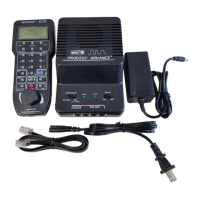Page: 15
Setting Time Rate (ratio) (Master Cab only)
The time rate is how many real seconds are in one fast clock minute.
EXAMPLE: Rate 1 means that one real second equals one fast clock minute, or 60 times
as fast as real time. Rate 30 means 30 real seconds equal one fast clock minute, or twice
as fast as real time. Rate 60 means 60 real seconds equal one fast clock minute, or real
time.
1. Make sure your Cab is the Master Cab.
2. Press SYS and 2. The current rate will be displayed for a second.
3. Enter the new ratio. Press ENTER.
Setting AM/PM or Military (24hr)
Time (Master Cab only):
1. Make sure your Cab is the Master Cab.
2. Press SYS and 4. Either “AM”, “PM” or
nothing (military) will display on the LCD.
3. Repeat step 2 above to select the desired
setting.
REVERSE LOOP
The following diagram shows a reverse loop
with a double-pole double-throw (DPDT)
switch. It allows you to change the polarity of the reverse loop section. Before a loco crosses
the rst insulated gap you must make sure
the polarity of reverse loop section and Main
Track are matched at the rst gap. If not ip
the switch. Otherwise it will cause a short
circuit. After the loco passes the rst gap
completely, you need to change the polarity of
the reverse loop section by ipping the switch
so that the polarity of the reverse loop section
and Main Track are matched at the second
gap. The MRC Auto Reverse Loop Module
(#AD520) can be used in place of the DPDT
switch for automatic operation of the loop.
See your hobby dealer to purchase this item.
ACCESSORY DECODERS
The Prodigy Advance
2
will handle most NMRA compatible accessory decoders. This type
of decoder can operate turnouts (switch tracks) or toggle accessories, like building lights,
on and o from your Cab. The accessory decoder outputs can be programmed for a variety
of options so you can use them for twin-coil switch machines (momentary on), slow-motion
switch machines (constant on or latching), or signal lighting (various ash rates). Refer to your
accessory decoder’s instruction manual for programming procedures and CV values.
Most accessory decoders have their own unique address (CV #513) and some have multiple
outputs (groups of 4). Accessory decoder’s and loco decoder’s addresses are dierent, so they
can be operated independently of each other (even if the address values are the same).

